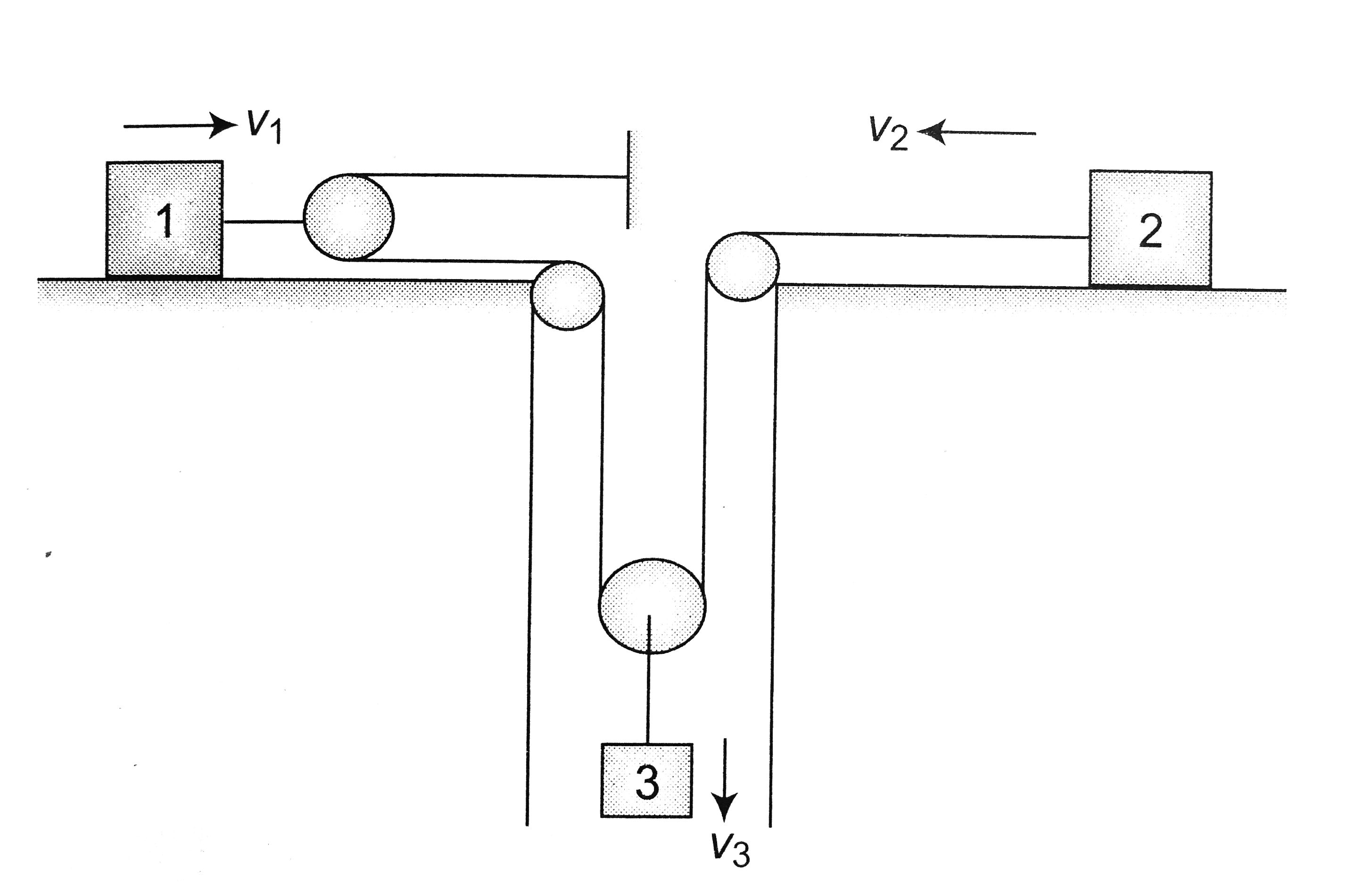From energy conservation principle prove the relations,
Ar=(v2−v1v1+v2)Ai and At=(2v2v1+v2)Ai
Here, symbols have their usual meanings.
The correct Answer is:A
To prove the relations Ar=(v2−v1)(v1+v2)Ai and At=2v2(v1+v2)Ai using the principle of energy conservation, we can follow these steps:
1. Understand the Power Relationship:
The average power of the incident wave Pi is equal to the sum of the average power of the reflected wave Pr and the average power of the transmitted wave Pt. This can be expressed as:
Pi=Pr+Pt
2. Write the Power Formulas:
The average power for a wave can be expressed as:
P=12μω2A2v
where μ is the linear mass density, ω is the angular frequency, A is the amplitude, and v is the wave speed.
3. Express Powers in Terms of Amplitudes:
For the incident wave:
Pi=12μ1ω2A2iv1
For the reflected wave:
Pr=12μ1ω2A2rv1
For the transmitted wave:
Pt=12μ2ω2A2tv2
4. Set Up the Energy Conservation Equation:
From the conservation of energy, we can write:
12μ1ω2A2iv1=12μ1ω2A2rv1+12μ2ω2A2tv2
We can cancel out 12 and ω2 from all terms:
μ1A2iv1=μ1A2rv1+μ2A2tv2
5. Substitute Mass Densities:
The mass densities can be related to wave speeds:
μ1=Tv1,μ2=Tv2
Substituting these into the equation gives:
Tv1A2iv1=Tv1A2rv1+Tv2A2tv2
Cancelling T and v1:
A2i=A2r+v1v2A2t
6. Relate Amplitudes:
Using the relationship Ar=At−Ai:
Substitute Ar into the equation:
A2i=(At−Ai)2+v1v2A2t
Expanding and simplifying gives:
A2i=A2t−2AtAi+A2i+v1v2A2t
Rearranging leads to:
2AtAi=A2t(1+v1v2)
7. Solve for At:
Rearranging gives:
At=2Aiv2v1+v2
Thus, we have proved:
At=2v2v1+v2Ai
8. Solve for Ar:
Now substituting At back into the equation for Ar:
Ar=At−Ai=2v2v1+v2Ai−Ai
This simplifies to:
Ar=(2v2−v1−v2v1+v2)Ai=(v2−v1)(v1+v2)Ai
Conclusion:
Thus, we have proved both relations:
Ar=(v2−v1)(v1+v2)AiandAt=2v2(v1+v2)Ai
The average power of the incident wave Pi is equal to the sum of the average power of the reflected wave Pr and the average power of the transmitted wave Pt. This can be expressed as:
Pi=Pr+Pt
The average power for a wave can be expressed as:
P=12μω2A2v
where μ is the linear mass density, ω is the angular frequency, A is the amplitude, and v is the wave speed.
For the incident wave:
Pi=12μ1ω2A2iv1
For the reflected wave:
Pr=12μ1ω2A2rv1
For the transmitted wave:
Pt=12μ2ω2A2tv2
From the conservation of energy, we can write:
12μ1ω2A2iv1=12μ1ω2A2rv1+12μ2ω2A2tv2
We can cancel out 12 and ω2 from all terms:
μ1A2iv1=μ1A2rv1+μ2A2tv2
The mass densities can be related to wave speeds:
μ1=Tv1,μ2=Tv2
Substituting these into the equation gives:
Tv1A2iv1=Tv1A2rv1+Tv2A2tv2
Cancelling T and v1:
A2i=A2r+v1v2A2t
Using the relationship Ar=At−Ai:
Substitute Ar into the equation:
A2i=(At−Ai)2+v1v2A2t
Expanding and simplifying gives:
A2i=A2t−2AtAi+A2i+v1v2A2t
Rearranging leads to:
2AtAi=A2t(1+v1v2)
Rearranging gives:
At=2Aiv2v1+v2
Thus, we have proved:
At=2v2v1+v2Ai
Now substituting At back into the equation for Ar:
Ar=At−Ai=2v2v1+v2Ai−Ai
This simplifies to:
Ar=(2v2−v1−v2v1+v2)Ai=(v2−v1)(v1+v2)Ai
Thus, we have proved both relations:
Ar=(v2−v1)(v1+v2)AiandAt=2v2(v1+v2)Ai
Topper's Solved these Questions
- SUPERPOSITION OF WAVESBook:DC PANDEYChapter:SUPERPOSITION OF WAVESExercise:Example Type 1
Explore 1 Video
- SUPERPOSITION OF WAVESBook:DC PANDEYChapter:SUPERPOSITION OF WAVESExercise:Example Type 2
Explore 1 Video
- SOUND WAVESBook:DC PANDEYChapter:SOUND WAVESExercise:Exercise 19.7
Explore 4 Videos
- THERMOMETRY THERMAL EXPANSION AND KINETIC THEORY OF GASESBook:DC PANDEYChapter:THERMOMETRY THERMAL EXPANSION AND KINETIC THEORY OF GASESExercise:Medical entrance gallary
Explore 30 Videos
Similar Questions
Knowledge Check
P1V1T1=P2V2T2 is -
ABoyle's LawBCombined gas lawCCharles LawDNone of theseGiven the set of vectors v1=(1,2,3):v2=(1,0,1) and v3=(0,1,0)
Athe set of vectors are not linearly independentBthe set of vectors are linearly dependentC(1,2,3)+(1,0,1)+(0,1,0)=0D(1,2,3)+(1,0,1)+(0,1,0)≠0Assertion : The average velocity of a particle having initial and final velocity v1 and v2 is v1+v2/2.
Reason : If r1 and r2 be the initial and final displacement in time t, then vav=r1−r2t .AIf both Assertion and Reason are correct and Reason is the correct explanation of assertion.BIf both Assertion and Reason are correct but Reason in not the correct explanation of Assertion.CIf Assertion is true but Reason is false.DIf Assertion is false but Reason is true.
Use graphical method to derive the relation v2−u2=2as, where the symbols have their usual meanings.
View SolutionUse velocity time graph to derive the relation : v2−u2=2 as, where the symbols have their usual meaning.
View SolutionA : Equation ofcontinuity is A1v1ρ1=A2v2ρ2 (symbols have their usual meanings).
R : Equation of continuity is valid only for incompressible liquids.
View SolutionThree block 1, 2 and 3 are arranged as shown in the figure. The velocities of the blockes v1 , v2 and v3 are shown in the figure. What is the relationship between v1 , v2 and v3 ?

View SolutionA particle moves along a straight line. Its velocity and speed are denoted by v1 and v2. The quantity v1v2
View Solution

